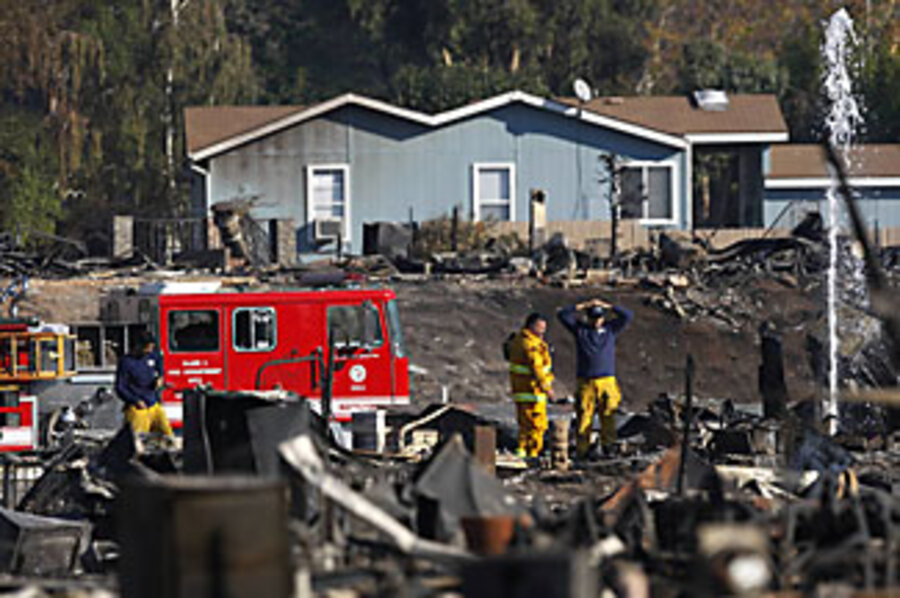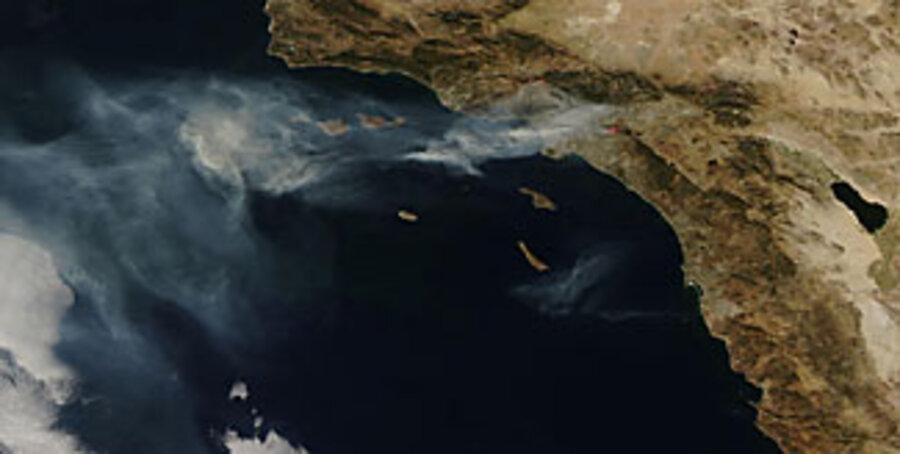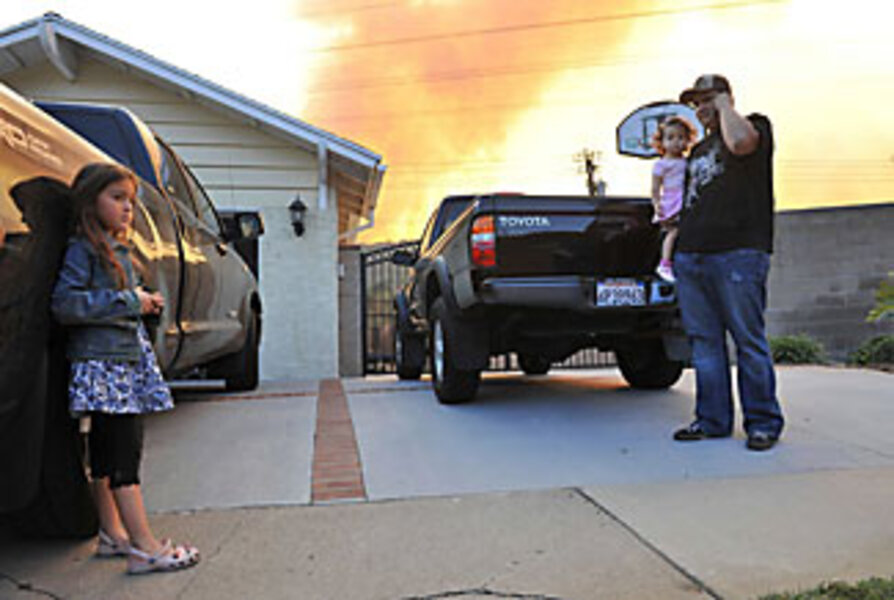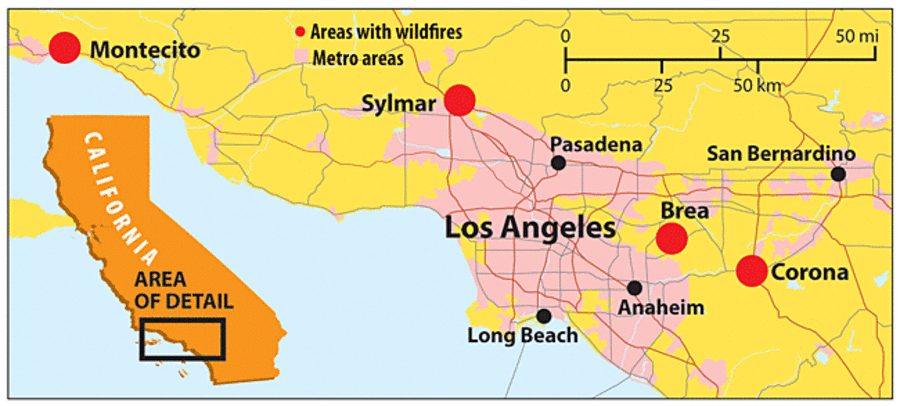California wildfire lessons: Steps by homeowners cut damage
Loading...
| Los Angeles
The dramatic news footage depicting towering walls of flame, exhausted firefighters, and plumes of smoke don't tell the story. Tearful, day-after tours of the rubble do.
That's when local newsmen with video cameras walk house to house and ask the troubling question: Why was this structure spared when the homes on both sides were incinerated?
Sometimes, even bigger questions nag. Why was this neighborhood obliterated while that one was passed over unscathed?
The facts are slowly emerging. Aside from the heroic efforts of firefighters, improved logistical planning by local officials, increased funding for better trucks, planes, flame retardant and other tools, a key factor in fighting fires here is the proactive initiative of homeowners.
Stricter enforcement of codes adopted by scores of communities in the past two decades has residents clearing out trees, brush, and shrubbery next to their homes. Also, homeowners and communities are taking voluntary preventive measures such as practicing fire-resistant construction.
New California building codes, which took effect in January, ban wood siding and wood-shake roofs from new construction in fire-prone areas. But residents in existing homes are also replacing wood shingles with cement tile and wood siding with stucco as well as rebuilding wood porches to be more fireproof. Entire developments have adopted so-called shelter-in-place construction.
The newer luxury development at Olinda Ranch, near Brea in Orange County, for instance – about 660 homes built with cement-tile roofs, stucco walls, and sprinkler systems – escaped with minimal charring, while the adjacent community of Oak Ridge lost nearly 500 homes. Many of those homes were in a mobile-home park, which prompted Gov. Arnold Schwarzenegger to call for a new review of state building codes.
"As a whole, we are learning the lessons of these giant fires," says Ana Cave, emergency manager for the town of Brea. "The truth is that we are doing better because of the newer technology, which has been a great success in these high-hazard areas. Some of the homes that went up in flames did so because people had lived there 30 to 40 years and had begun to take it for granted that nothing would happen because nothing had happened so far."
Because of seasonal Santa Ana winds, which speed down out of the Great Basin and Mojave Desert and scorch the ever-drier chaparral, one of the biggest problems in fighting southern California wildfires is airborne embers. This past week, winds reached 80 miles per hour several times over four days of intense fire. Besides blowing ahead of firefighters into entirely new areas of dry tinder, the embers landed on the tops of houses that then smoulder and ignite.
A major problem is that these embers get sucked into air ducts under eaves, a 2007 study by the Institute for Building and Home Safety (IBHS) showed. The findings have led to the construction of boxed eaves, which prevent such activity, and a new kind of mesh grate, which allows eaves to breathe but won't let ember-size sparks pass through.
"California codes are fine, but one of the necessary changes is in these vents," says Julie Rochman, president and CEO of IBHS. "Otherwise, residents think everything is fine, and then suddenly a new home is burning from the inside out."
By press time Tuesday, three major fires in southern California had destroyed nearly 1,000 homes and apartments and burned 42,000 acres, or 65 square miles, forcing mass evacuations. One had been contained and the remaining two were at least 70 percent surrounded, according to the California Department of Forestry and Fire Protection.
The first of the wildfires broke out in the Montecito area of Santa Barbara County, about 90 miles northwest of Sylmar. It destroyed 210 homes, many of them ocean-view mansions. It was fully contained Monday night.
Governor Schwarzenegger on Monday asked the Bush administration to declare southern California a federal disaster site. The governor also requested disaster loans for the counties of Los Angeles, Orange, Riverside, Santa Barbara, and San Bernardino. He said many of the residents affected by the fires – particularly mobile-home owners – lacked insurance or are underinsured.
The causes of all three fires were under investigation. Officials labeled the Santa Barbara-area fire "human-caused."
The problem of natural wildfires is not merely a California issue, Ms. Rochman says. As more and more residents have gotten tired of cities and moved to rural areas, many Americans now live in the wildland-urban interface in 38 states, including Michigan, South Carolina, and Colorado. Putting homes in such areas dramatically increases the risk of devastating forest fires because homes burn so much hotter than forests alone.
People who move to such areas are, by definition, trying to move away from others to obtain privacy and don't like being told what to do, says Rochman. The economic downturn makes them doubly reluctant to make costly improvements.
"We find that these types are less inclined to obey regulations about shrubbery and brush," says Rochman. Her strategy is to give residents economic incentive by informing them that fire-preventive measures, such as double-pane windows, are also energy savers. "We have to tell them that if they spend the extra money on these windows, they will at least be saving on their energy bills," she says.








